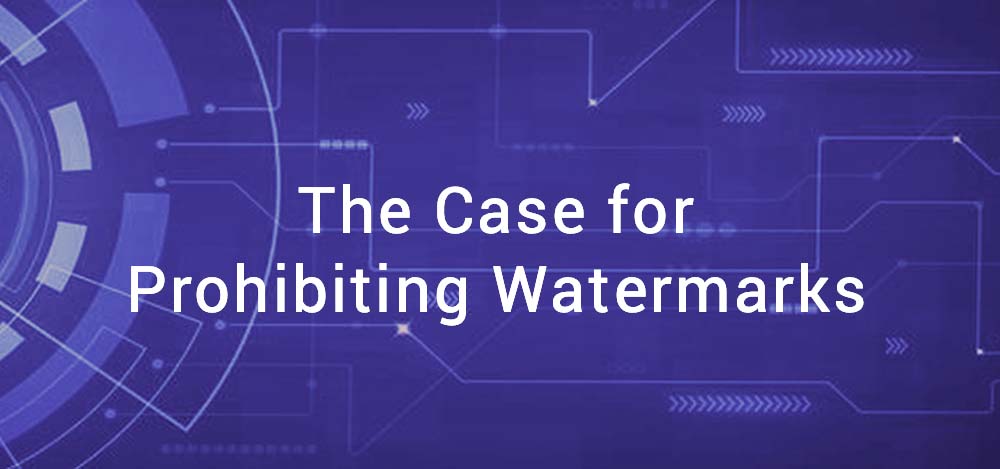By Nathan Brannen on 3 September 2019
If you've followed the major marketplaces over the past few years, you'll know that there has been a large discussion on the best way to moderate user generated content, and in particular, watermarked images.
Is it best to prohibit them? Should it be up to the seller? What are the consequences? It's all surprisingly more complex than it seems.
Based on what we've seen in the market from both our customers and the larger trends, I want to dive a bit deeper into what makes this such a divisive issue before providing a few suggestions on the best approach for implementing a watermark policy on your own marketplace or portal.
So, what are the giants doing?
Looking at the larger companies with the size and reach to shape best practices, we see a variety of approaches.
Some players, like Google Shopping and Amazon, have taken a hard stance. They do not allow any watermarks, logos or artificially added text.
Others, such as Facebook and Instagram, have taken a slightly more lenient approach. Their detailed guide (with examples!) states that ads with added text, logos and watermarks covering greater than 20% of the image may not be shown.
Last of all, I want to mention eBay, perhaps the most interesting case. eBay was planning to enforce a ban on all watermarks in images and even set a date of March, 1 2018 to supply their users with time to comply with the change. However, not more than a few months later, they backtracked. Their users had pushed back so hard that eBay changed their stance to a simple suggestion.
It's clear these behemoths share a preference for listing images without watermarks, but their reactions vary. Why?
Let's start from the beginning and look at why portals and marketplaces would want to keep their listings watermark-free.
Three reasons to block watermarks
The following three arguments are the greatest reasons our customers have brought up when discussing why they want to detect and remove watermarked images on their sites.
1. Better and more consistent user experience
The clearest and most obvious reason to ban watermarks is that they take attention away from the product or listing.
As a buyer on a given marketplace or portal, you want to be able to browse through different listings to find what you want as quickly as possible.
Now take a look at a representative sample of how we've seen watermarks applied on our customers' sites.

What. A. Mess.
As a user clicking between different listings, the inconsistency is a nightmare. It requires the brain to spend unnecessary time and effort filtering out what is relevant.
Simply put, the different shapes, sizes and locations of the watermarks make the buying process more difficult.
2. Increased click-through-rates (CTR's)
Now, some people reading this may be more analytical. They may agree that watermarks are not ideal, but they need to know how much they impact a listing.
While the previously referenced Facebook guidelines state their policy towards watermarks is due to a decrease in click performance, unfortunately, it does not specify by how much.
However, we do have some numbers.
In our experience working with clients using our watermark solutions, we've seen that an image without a watermark is up to 4 times more likely to be clicked than the same image with a watermark. The exact magnitude differs by geography and industry, but a negative impact on CTR can always be seen.
For our clients that have decided to permit watermarks, they have minimized the negative impact on CTR by enforcing guidelines that limit watermarks to a certain size and force them to be located in a pre-defined area.
3. Prevent competitors from pulling people off your site
Beyond the aesthetics, permitting watermarks can have an even more detrimental effect if the watermark leads users off your site.
Watermarks commonly feature the name of the company, if not the website or phone number, responsible for the listing. With a simple Google search, a user can find the very same product on that company's own site.
Even if the user is not tempted away from your site, these watermarks provide companies a way to freely promote their brands in a pronounced and visual way to your users.
As most marketplaces and portals are dependent on their traffic and/or the number of transactions executed on their platform, the last thing you want to do is to present your users with alternative sites.
Three challenges to banning watermarks
Up until now, I've mainly focused on the downsides of watermarks, but if it was that easy, then there wouldn't be a need for this article. I'll now present three of the main challenges that prevent platforms from prohibiting watermarks.
1. Potential customer backlash
As the eBay example at the beginning of the post mentioned, marketplaces and portals need their users to buy-in to the rule. Otherwise, they risk damaging their relationship with the supply side of their platform.
What are some of the reasons users would reject a policy that leads to higher conversions?
Well, first of all, many users see watermarks as the only way to protect their images, which are their intellectual property. Without their watermark, they fear that their images will be stolen and used by others.
Fortunately, many new companies are offering reverse image searches that identify whether your images are being used illegally. You can then easily submit take down notices and/or pursue legal compensation. Some of these companies will even monitor your photos for free in return for a portion of the settlements their legal team secures.
Another complaint users often have is that they can't easily access and replace their photos with compliant images. They have used watermarks for so long that they are not sure where to find the corresponding watermark-free images.
2. Your competitor allows them
Another reason it is important to make sure your clients are on board with a change in watermark policy is that many times their users have alternative places to post their listings.
Google and Amazon may have the size and market strength to force their users to comply, but this is not the case for many marketplaces and portals.
In fact, in many countries there are often duopolies, where there are two major players vying for the supply side's listings. They worry that if they enforce a strict watermark policy, their users may simply switch platforms. In these cases, it is much easier to keep the status quo rather than risk their entire business.
The customers we've worked with in markets like this have had success by providing incentives or prioritization to listings that do not contain watermarks.
3. Additional costs
Last of all, many companies are unsure of how to enforce a policy against watermarks. How do they determine whether a photo has a watermark?
In Asia, it is common to use manual teams that review every photo, but labor is too expensive in many other countries to make this a viable option. It also introduces a lag between when a listing is posted and when it gets reviewed, and therefore, posted to the platform. These problems only become worse as the platform grows and the company constantly needs to scale its manual moderation team.
Things have become easier with technology. For example, using computer vision to automatically detect watermarks allows marketplaces and portals to instantly know whether images have watermarks. The images can even be blocked as soon as they're uploaded.
In both cases though, these processes require money and a budget that many marketplaces and portals may not have planned on using.
Best practices for implementing a watermark policy
Given these challenges, there are several things we'd recommend you consider if you're looking to implement a stricter watermark policy.
First of all, ensure that your users are aware of the reasons for the change and given a timeline so they can adapt. Additionally, make sure they're aware of the technologies available to protect their photos without using a watermark.
If your users push back on a complete ban, consider a compromise where watermarks are allowed, but must be below a certain size or in a specific, constant location. To aid policies like this, we developed customizations for our watermark detection solution that enable it to determine whether watermarks are acceptable based on pre-specified size and location criteria.
Last of all, consider implementing a soft policy. Once you are able to detect the watermarks, you can simply de-prioritize the ranking of those listings rather than banning them completely. In this case, users will be able to see a clear improvement in their results' rankings as they remove their watermarked images.
If you have any thoughts, please reach out. I'd love to hear about the specifics of your situation and see if we can help in any way. In the meantime, I encourage you to play with our free watermark detection demo.




comments